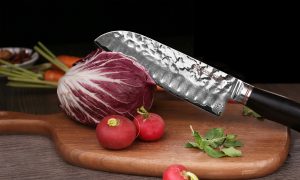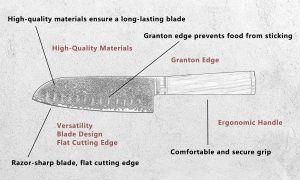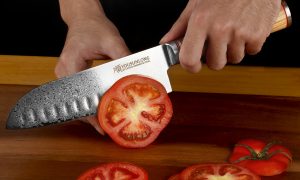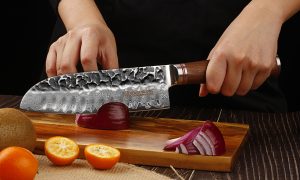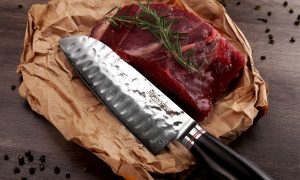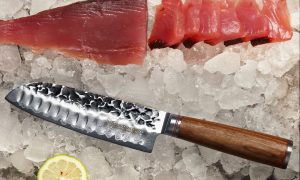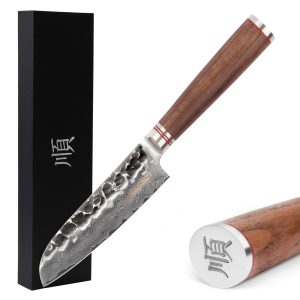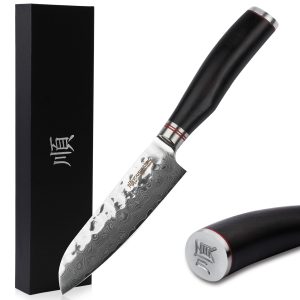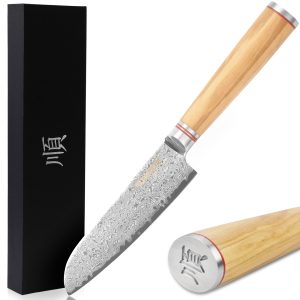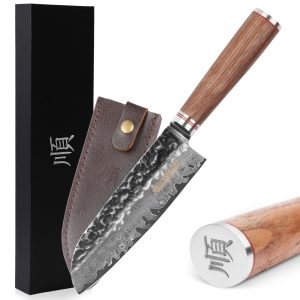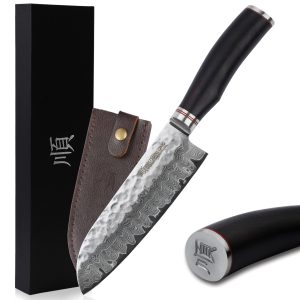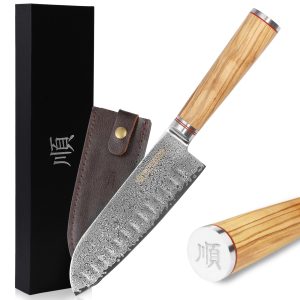1. Unveiling the Versatile Santoku Knife
A Santoku knife, also known as Santoku Bocho, is a type of Japanese knife that embodies the concept of “Three Virtues.” This refers to its versatility in handling meat, fish, and vegetables, as well as its primary functions of chopping, slicing, and dicing.
Compared to Western knives, Santoku knives have shorter and wider blades. Its compact size offers excellent control and maneuverability, making it a preferred choice for many cooks. Whether you’re preparing a delicate seafood dish or chopping vegetables for a stir-fry, the Santoku knife delivers exceptional results every time and is a trusted culinary companion in your kitchen.
2. Exploring the Incredible Features of a Santoku Knife
When it comes to the features of a Santoku knife, there are several aspects that make this knife truly remarkable.
Versatility: The Santoku knife is known for its versatility in the kitchen. It excels at slicing, dicing, and chopping various ingredients, including meat, fish, and vegetables. From delicate herbs to thick cuts of meat, the Santoku knife can handle it all with ease.
Blade Design: The blade design of a Santoku knife sets it apart from other knives. It typically has a shorter length compared to Western-style knives, but with a wider blade. This design allows for better control and precise cutting motions.
Granton Edge: Many Santoku knives feature a granton edge, which consists of small oval-shaped indentations along the blade’s side. These indentations create air pockets, reducing friction and preventing food from sticking to the blade while cutting. This feature ensures clean and effortless cuts every time.
Flat Cutting Edge: The flat cutting edge of a Santoku knife provides stability and accuracy during slicing. It allows for a smooth rocking motion, making it easier to dice or chop ingredients uniformly.
Ergonomic Handle: Comfort is an important aspect of any knife, and the Santoku knife delivers with its ergonomic handle design. The handle is crafted to fit comfortably in hand, offering a secure grip and reducing fatigue during extended use.
High-Quality Materials: Santoku knives are often crafted from high-quality materials such as Damascus steel or high-carbon stainless steel. These materials ensure excellent edge retention, durability, and resistance to corrosion.
3. Mastering the Art of Santoku Knife
The Santoku knife is not just a kitchen tool; it is an art form that can elevate your culinary skills to new heights. Here are four key techniques to master with a Santoku knife.
(1) Slicing
The Santoku knife’s razor-sharp blade and flat cutting edge make it ideal for precise slicing. Whether it’s carving thin slices of meat or creating paper-thin vegetable slices, the Santoku knife delivers unparalleled control and precision.
(2) Chopping
With its wider blade and sturdy construction, the Santoku knife is perfect for chopping tasks. From large chunks of vegetables to boneless meats, the Santoku excels in delivering clean and uniform cuts. Its shorter length also allows for better maneuverability when tackling tougher ingredients.
(3) Dicing and Mincing
Achieving consistent dices and fine minces is effortless with a Santoku knife. Its agile nature and excellent balance make it easy to dice onions, garlic, herbs, or any small ingredient with speed and accuracy. The combination of a sharp blade and granton edge prevents food from sticking, ensuring smooth and efficient dicing and mincing.
(4) Filleting
Although not as common as the first three techniques, the Santoku knife can be a versatile tool for filleting fish. Its thin, flexible blade allows for precision and control while removing bones and skin. However, it’s important to note that specialized fillet knives may still be the preferred choice for delicate filleting tasks.
4. Santoku vs. Other Japanese Knives
While the Santoku knife is a popular Japanese knife, it’s important to understand how it compares to other traditional Japanese knives. Here are five notable Japanese knives and their distinct features.
(1) Nakiri knife
The Nakiri knife is primarily designed for cutting vegetables. It has a straight blade with little to no curve, allowing for precise up-and-down chopping motions. Unlike the Santoku, which has a wider blade, the Nakiri knife has a thinner and lighter blade, making it ideal for fine vegetable work.
(2) Deba knife
The Nakiri knife is primarily designed for cutting vegetables. It has a straight blade with little to no curve, allowing for precise up-and-down chopping motions. Unlike the Santoku, which has a wider blade, the Nakiri knife has a thinner and lighter blade, making it ideal for fine vegetable work.
(3) Gyuto
The Gyuto knife is often considered the Japanese equivalent of a Western chef’s knife. It shares similarities with the Santoku in terms of versatility, as both can handle various cutting tasks. However, the Gyuto typically has a longer, narrower blade compared to the Santoku, providing more slicing power and allowing for fluid rocking motions.
(4) Yanagiba
The Yanagiba knife is specifically designed for delicate slicing of raw fish, particularly for sushi and sashimi preparation. It has an extremely sharp, slender blade with a long, single bevel edge. While the Santoku can handle slicing tasks, the Yanagiba’s specialized design makes it the preferred choice for achieving thin, precise cuts in seafood.
(5) Kiritsuke
The Kiritsuke knife is a multipurpose Japanese knife that combines features of both a Yanagiba and a Usuba knife. It has a long, single bevel blade with a slightly curved tip, making it suitable for both slicing and precision vegetable work. The Kiritsuke is a versatile knife but requires advanced knife skills due to its complex design.
In summary, while the Santoku knife shares some similarities with other Japanese knives, each has its own unique purpose and design. The Santoku excels in versatility, handling various cutting tasks with ease, while specialized knives like the Nakiri, Deba, Gyuto, Yanagiba, and Kiritsuke cater to specific culinary needs. Choosing the right knife ultimately depends on your cooking preferences and the specific tasks you regularly undertake in the kitchen.
5. Top YOUSUNLONG Santoku Knife Recommendations
【YOUSUNLONG Santoku Knife 5 Inch】
When it comes to top YOUSUNLONG Santoku knife recommendations, the 5-inch knife with a Japanese hammered Damascus steel blade stands out. This knife boasts an ultra-sharp and durable blade that is perfect for precision cutting tasks in the kitchen. The natural wooden handle not only provides a comfortable grip but also adds an elegant touch to the knife’s overall design. Its compact size makes it ideal for versatile use, from slicing and dicing to mincing herbs with ease, it is a reliable and stylish tool. Experience the excellence of YOUSUNLONG craftsmanship with this exceptional Santoku knife.
【YOUSUNLONG Santoku Knife 7 Inch】
The 7-inch Santoku Knife is a sight to behold! Crafted with a Japanese hammered Damascus steel blade, this knife exhibits exceptional sharpness and durability. The unique pattern on the blade adds elegance to its design. The natural wooden handle not only offers a comfortable grip but also showcases the beauty of natural materials. This versatile Santoku knife is perfect for slicing, dicing, and chopping various ingredients with precision. Whether you’re a professional chef or a home cook, the YOUSUNLONG Santoku knives provide an excellent balance of performance and aesthetics.
They make perfect gifts for anyone passionate about cooking and appreciating fine cutlery.
